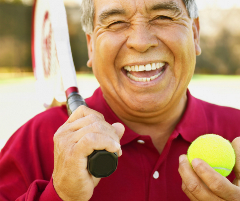Tennis elbow: not just for tennis players!

Tennis Elbow Explained
Download Tennis Elbow Fact Sheet
Since the creation of modern tennis in 1873, participants have suffered from pain in and around the elbow of their racket arm. The first documented medical reference to the condition of tennis elbow or "lawn tennis arm" was published in 1883 with recommendations including treating the problem with rest and compression bandages fixed just distal to the painful area of the forearm. The situation has not changed greatly over the past 125 years. Half of all tennis players will suffer from tennis elbow at some time during their playing careers, and players still employ compression wraps to alleviate pain. However, the average person who develops tennis elbow is not a tennis player. Only five per cent of those who suffer from tennis elbow are injured due to their participation in the sport of tennis. Most often the injury results from excessive use of such tools as a hammer or screwdriver.
What is tennis elbow?
Research into the etiology of tennis elbow has revealed that it is primarily an overuse injury that results in micro tears of the hyaline region of the extensor muscles that attach on the lateral side of the forearm. However, pain localized on the medial side of the elbow is also possible. The actual diagnosis of tennis elbow is often incorrect because it is termed tendonitis. This expression has been disputed by elbow injury experts, who note that tendonitis implies inflammation of the affected region. The most common form of tennis elbow (lateral epicondyle tendinosis) is a painful condition that rarely presents with any inflammation. This terminology echoes the belief that this injury is degenerative rather than acute.
One of the common problems with tennis elbow is incorrect diagnosis. This occurs because at least 43 different pathologies of the elbow joint have been documented. Because the pathology of the injury is seen primarily at the microscopic level, it is relatively easy to misclassify tennis elbow in the intact human arm as bursitis, arthritis, or one of many other ailments. Proper diagnosis often relies on knowledge of the patient. The following list of characteristics are typical of those most likely to suffer from elbow tendon injuries:
-Over 35 years of age
-High activity level (athletic or occupational) three times or more per week
-30 minutes or more per session
-Demanding activity technique
-Poor fitness level
Typical treatments and prognosis
Tennis elbow can be placed into one of two categories: those that respond to conservative treatment and those that resist conservative treatment and indicate a need for surgical intervention. Conservative treatments include rest, ice, anti-inflammatory medications, physical therapy, and steroidal injections. In most cases, the single best treatment for lateral epicondyle tendinosis is rest. Giving the body time to heal will usually provide complete recovery from all but the most severe cases of tennis elbow. Unfortunately, most of those who suffer from the injury do not have the luxury or inclination to rest for long periods of time. Rest is not an option for those who must use their arms for occupational duties or athletes who may simply refuse to limit their activity. These individuals may benefit from the use of a tennis elbow strap or counterforce brace to mute or eliminate the pain associated with tennis elbow.
For the average person who develops a single occurrence of tennis elbow the condition is self-limited with all symptoms usually disappearing between 9.6 and 12 months. One of the mysteries of tennis elbow is that while the injury strikes approximately half of the tennis- playing population, 90 per cent of those who are afflicted eventually report the loss of all related symptoms and associated pain sometime after their 50th birthdays. Nearly all patients who have surgery for severe tennis elbow improve, and more than 85 per cent of these individuals return to their pre-injury levels of activity.
Prevention
Using proper biomechanics and suitable equipment for the size and skill of the individual may be the best strategy for preventing tennis elbow. In general, a neutral wrist position should be maintained during the activity. This can be achieved by a tennis player through the selection of the correct grip size and expert consultation relative to proper gripping technique. The use of a two-handed backhand stroke greatly reduces the stress on the elbow and will reduce the likelihood of injury. Strengthening and stretching are also advantageous and can be prescribed by a health care professional. The intensity of activity is also important. New activities should be started slowly and the intensity should be increased slowly. If elbow pain is experienced, the activity should be suspended.
Summary
Tennis elbow is a significant problem that can prevent people from performing athletically and occupationally. Improvements in equipment, technique, strength and conditioning all help to reduce the likelihood of injury, but lateral epicondyle tendinosis is an overuse injury that will continue to strike active individuals. Fortunately, the prognosis for recovery is very good once the condition is properly diagnosed and treated.
Download Tennis Elbow Fact Sheet
Written for the American College of Sports Medicine by Jeffrey A. Bauer, Ph.D. and Mark Tillman, Ph.D.
Suggested Citation: Bauer, J. and Tillman, M. Tennis Elbow. Indianapolis, IN: American College of Sports Medicine; 2017.ACSM Sports Medicine Basics are official statements by the American College of Sports Medicine concerning topics of interest to the public at large.
ACSM grants permission to reproduce this fact sheet if it is reproduced in its entirety without alteration.